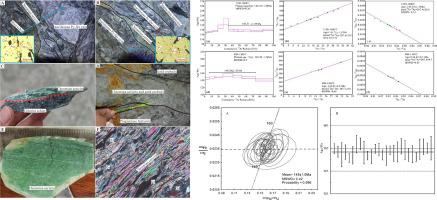Ore Geology Reviews ( IF 3.2 ) Pub Date : 2022-07-13 , DOI: 10.1016/j.oregeorev.2022.105027 Fei-Peng Fan , Fan Xiao , Shi-Zhong Chen , Guang-Fu Xing , Yan Zhou , Fan Chen

|
The shuangqishan and Xiaoban are the two largest gold deposits in the Dehua-Youxi-Yongtai (DYY) mineral concentrated area of central Fujian Province. They are located adjacent to each other and show similarities in geological background, metallogenic characteristics and mineral assemblage. The orebodies are hosted in the Caledonian alaskite and the metamorphic rock of Neoproterozoic Daling Formation. Gold mineralization is closely related to pyritization, silicification, and micatization, with native gold mostly occurring in the cracks of pyrite, which formed slightly later than pyrite. In this paper, geochronologic work has been conducted on the granite porphyry and chromian sericite related to gold mineralization in the two deposits to determine the age of mineralization and discuss the genesis of the deposits. The chromian sericite is a hydrothermal alteration product of granite porphyry, and is a main indicator of gold enrichment. The plateau 40Ar/39Ar isotopic dating of chromian sericite indicates the mineralization ages of the two deposits were 146.21 ± 1.59 Ma and 149.28 ± 1.26 Ma respectively, similar to the LA-ICP-MS zircon U-Pb age(149.0 ± 1.0 Ma) of granite porphyry in the mining district. The ages of the chromian sericite and granite porphyry point to a close link with a large-scale magmatism event at the late stage of Late Jurassic in central Fujian. Based on the geology, alteration, mineralization and chronology characteristics, the Shuangqishan and Xiaoban gold deposits can be classified as the magmatic hydrothermal type gold deposits.
中文翻译:

闽中、华南地区双岐山、小坂金矿花岗斑岩LA-ICP-MS锆石U-Pb定年及铬绢云母40Ar/39Ar定年及其对金成矿的制约
双旗山和小坂是闽中德化-尤溪-永泰(DYY)矿产集中区最大的两个金矿。它们彼此相邻,在地质背景、成矿特征和矿物组合上表现出相似性。矿体赋存于加里东期alaskite和新元古代大岭组变质岩中。金矿化与黄铁矿化、硅化、云母化密切相关,原生金多出现在黄铁矿的裂缝中,形成时间稍晚于黄铁矿。本文对这两个矿床中与金成矿有关的花岗斑岩和铬长绢云母进行了地质年代学工作,以确定成矿年龄并讨论了矿床的成因。铬质绢云母是花岗斑岩的热液蚀变产物,是金富集的主要标志。高原铬绢云母的40 Ar/ 39 Ar 同位素测年表明,两个矿床的成矿年龄分别为 146.21 ± 1.59 Ma 和 149.28 ± 1.26 Ma,与 LA-ICP-MS 锆石 U-Pb 年龄(149.0 ± 1.0 Ma)相似矿区的花岗斑岩。铬质绢云母和花岗斑岩的年龄与闽中晚侏罗世晚期的一次大规模岩浆活动密切相关。根据地质、蚀变、成矿及年代学特征,双岐山和小坂金矿可归为岩浆热液型金矿。











































 京公网安备 11010802027423号
京公网安备 11010802027423号